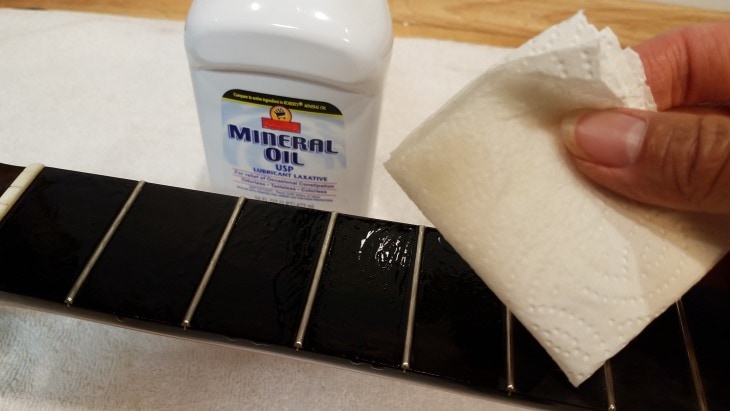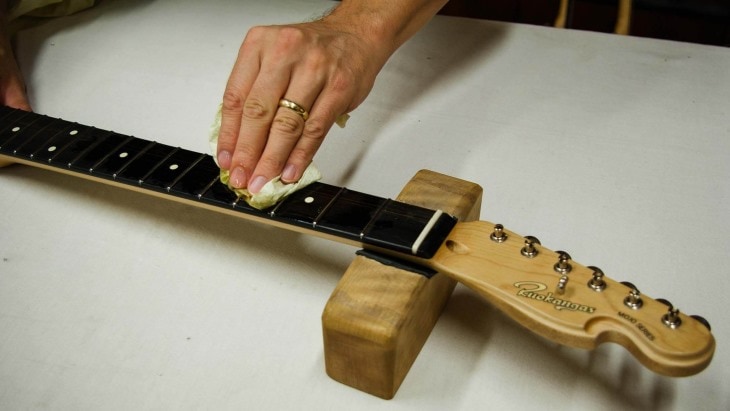Oiling your guitar’s fretboard is something you should do periodically. This will maximize the playing comfort of the instrument, allowing you to transition up and down the frets more efficiently. Oiling is a great way to keep the fretboard in good condition.
Before you apply oil to the fretboard, it’s important to ensure that you’re using the correct solution. This depends on the tonewood that the fretboard is made from, whether it is rosewood, maple, or another material.
In this guide, you’ll learn the most effective ways to oil your guitar’s fretboard, and some additional tips to keep your instrument feeling, looking, and sounding fresh.
Table of Contents
Why You Need to Oil Your Guitar Fretboard

Although it’s advisable to oil your fretboard, we all know guitarists who have never performed any maintenance to their instrument and despite that, their guitar is still in brilliant condition.
Oiling your fretboard ultimately makes the wood feel smoother, due to the moisture it retains. If you prefer a rough-feeling fretboard, by all means, leave it alone. However, if you’ve noticed a build-up of dirt after years of playing, it’s probably time to give your guitar some much-needed TLC.
The wood that your fretboard is made from is constantly changing throughout the guitar’s life. You might notice new marks appearing, or the wood taking on a different shade from when you first acquired the instrument.
When the guitar was originally manufactured, the fretboard will have been sufficiently oiled and moisturized. However, the more you play the instrument, the more dirt, sweat, and other unwanted substances make their way onto the wood.
Therefore, oiling the fretboard once in a while is a great way to keep the guitar feeling fresh, revitalized, and playable.
Words of Warning
Before we get into the best oils and methods to use on your guitar’s fretboard, I want to make one thing clear. The oil that you choose matters, a lot! So before you reach for the olive oil, peanut oil, or canola oil, think twice.
The oils that we use for culinary purposes are not suitable for your guitar. The reason for this is quite simple. These oils eventually turn bad, when they pass their best before date.
Due to the fretboard wood being absorbent, any oil that you apply to it will soak into the material, and stay there for a long time. If you use the wrong oil, it will detrimentally affect your fretboard.
In the short-term, applying any type of oil to the fretboard will make it look better and feel smoother. However, this initial improvement will be followed by the oil going bad when it is deeply embedded into the fretboard wood.
Now that we’ve established that you can’t use any old oil for this purpose, let’s take a look at the correct practices and measures you should take.
Types of Oils for Guitar Fretboards

Lemon oil is a popular choice for guitar fretboards. However, due to the acidity, it’s best if the lemon oil is mixed with some other ingredients to prevent it from stripping away the top later of the wood.
Thankfully, there are many great fretboard oils available that have been specially formulated for this purpose. These oils often include several ingredients, which provide the wood with the optimal amount of oil.
I’ve personally used and recommend lemon oils from Dunlop and D’Addario.
You can get specialized oils for the particular material that your fretboard is composed of. Rosewood and maple fretboards can generally use the same oils, but rarer woods like Pau Ferro may require a particular composition of oil.
The MusicNomad F-One is a great fretboard cleaner & conditioner oil for unfinished maple, ebony and rosewood fretboards.
Best Oil for Ebony Fretboard
Ebony is a highly prized wood for fretboards because of its extraordinary density. Ebony’s deep, dark brown color makes it look beautiful on a guitar, and because it is so compact, it makes for a smooth, easy playing experience.
In fact, ebony is so dense that, unlike most woods, it will sink in water instead of floating.
This density means that ebony is highly durable. Another factor in ebony’s durability is its naturally high oil content.
Ebony does not require oiling to make it water-resistant.
For this reason, ebony fretboards are typically left unfinished. You don’t need a sealing oil finish on ebony fretboards like this.
However, an unfinished ebony fretboard will naturally dry out with age.
All unfinished fretboards, including ebony, need occasional conditioning. For this, you need a mineral oil. You don’t want a “drying oil” that will harden into a glossy finish. You just need it to penetrate the pores of the wood and lubricate it a little.
Most guitar stores sell “lemon oil” that is a mineral oil with a lemon scent. This is great for unfinished fretboards.
Best Oil For Indian Laurel Fretboard
Indian Laurel is, as the name implies, a type of laurel tree native to South Asia.
Its use in guitar building has increased in recent years as more conventional fretboard woods (like rosewood) become rarer and more expensive.
Indian Laurel feels quite soft beneath your fingers, and is typically left unfinished. Players who are used to glossy Fender maple fretboards or rosewood often notice that laurel feels dry.
This can create an unpleasant “friction” feeling beneath a player’s fingers. To counteract this, and prolong the life of your Indian Laurel fretboard, we recommend using an oil to lubricate and nourish the wood.
Indian laurel is quite porous, so I often find it requires more frequent oiling than other woods. Any high quality mineral oil will do the trick. You can find these at most guitar stores, often labeled as “lemon oil” or fretboard cleaner.
Best Oil for Pau Ferro Fretboard
Pau Ferro is a South American wood that has enjoyed a recent surge in popularity.
Its visual and sonic similarity to rosewood have made it a popular alternative for luthiers seeking lower-cost alternatives to the increasing cost of quality rosewood.
Pau ferro is harder than rosewood despite its visual similarity, so it has a tighter feel under your fingers and more bite and snap in the guitar’s tone. This is particularly pronounced on Fender guitars as these typically have a bright tone to begin with.
Like rosewood, pau ferro is typically left unfinished on the guitar. Because of this, it can dry out over time, and requires occasional oiling to keep it clean and in good condition.
The same lemon oil that you use for ebony or rosewood fretboards works great for pau ferro. You can effectively treat it the same as you would treat rosewood.
Use a penetrative mineral oil such as lemon or almond oil that you can get from a guitar store. Dunlop offers two oils: one for cleaning, and one for conditioning, designed for use with one another.
I like using this two-step care method for pau ferro as it brings some extra luster out of the wood, which can look pale next to genuine rosewood.
How to Safely Oil Your Fretboard
The process of applying the oil to your fretboard is relatively straightforward. All that you need to do is remove the strings, and use a smooth, clean cloth. Apply your chosen oil to the fretboard sporadically. Then gently rub it onto the wood in a circular motion.
It’s important to make sure you run the oil evenly across the fretboard, otherwise, it might end up looking inconsistent. Starting at the headstock and gradually applying the oil to each fret is a good idea.
Once the oil is applied evenly, leave the guitar to dry for an hour or so. Then, re-string, and enjoy the added smoothness of your newly oiled fretboard.
Summary
Oiling guitar fretboards may not be the most exciting thing you can do with your instrument, but it’s important, nonetheless. If you want your instrument to remain playable for a long time, I’d highly recommend oiling it now and then.
Just be sure to get the right oil for your particular wood type. Pre-made oils state clearly which woods they are compatible with. So, provided you do some research, you can’t go wrong!


THANK YOU! I just purchased a brand new Washburn J3 with rosewood fretboard. It looks to be very dry. Should I go about oiling it slowly with thin coats of oil?